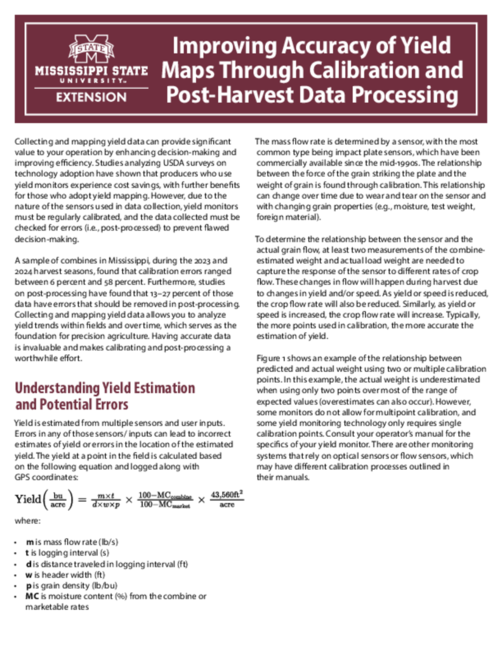P4133
Improving Accuracy of Yield Maps Through Calibration and Post-Harvest Data Processing
Collecting and mapping yield data can provide significant value to your operation by enhancing decision-making and improving efficiency. Studies analyzing USDA surveys on technology adoption have shown that producers who use yield monitors experience cost savings, with further benefits for those who adopt yield mapping. However, due to the nature of the sensors used in data collection, yield monitors must be regularly calibrated, and the data collected must be checked for errors (i.e., post-processed) to prevent flawed decision-making.
A sample of combines in Mississippi, during the 2023 and 2024 harvest seasons, found that calibration errors ranged between 6 percent and 58 percent. Furthermore, studies on post-processing have found that 13–27 percent of those data have errors that should be removed in post-processing. Collecting and mapping yield data allows you to analyze yield trends within fields and over time, which serves as the foundation for precision agriculture. Having accurate data is invaluable and makes calibrating and post-processing a worthwhile effort.
Download the PDF for the full publication.
Publication 4133 (POD-09-25)
By Jessica Drewry, PhD, Assistant Professor, Agricultural and Biological Engineering; John Lowe, PhD, Assistant Professor, Agricultural and Biological Engineering; Mike Mulvaney, PhD, Associate Professor and Endowed Chair, Plant and Soil Sciences; and Corey Bryant, PhD, Assistant Professor, Delta Research and Extension Center.
The Mississippi State University Extension Service is working to ensure all web content is accessible to all users. If you need assistance accessing any of our content, please email the webteam or call 662-325-2262.
